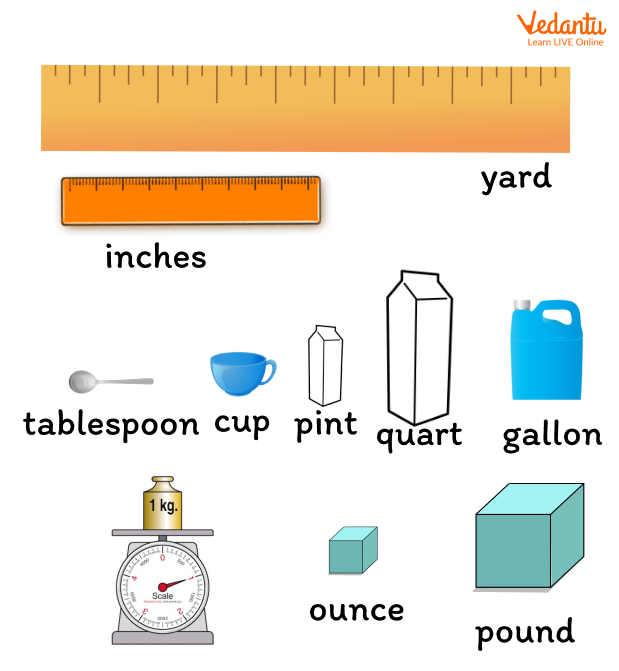




Do you know what is the most exciting and challenging moment of someone's life? Most probably when you step into school life, isn't it? Yes. It is a major transition not only for a child, but for the whole family. It generates curiosity and new expectations in the young mind. For the cognitive learning of a child, it is necessary to evaluate the performance of him or her.
The mathematical aptitude and reasoning ability of a child are important parameters. To evaluate the performance of a child of age 5 to 6 in Mathematics, pre-number concepts are necessary to address. Let’s learn more about it ahead!

Different measuring units
Measurement in Year 1 for Kids
In Year 1, the child is introduced to the pre-number concepts, which are generally known as the foundation ideas of Mathematics. These are generally related to identifying the quantity, size, distance, length, width, height and weight of any object. It also helps us with identifying the shape of various objects and identifying the area or space occupied by them.
A child’s ability in measuring in Year 1 also involves the introduction of currency or money.
How to Introduce Your Child to Measurement?
There is no particular method to introduce measurement to a child. The best way to develop measuring skills in Year 1 is to allow them to interact with the immediate environment. If all the five senses grow in a child then it will help for holistic learning of a child.
According to NCERT, encouragement of 3E’s, i.e., Exploration, Experimentation and Enquiry helps children’s learning in the cognitive domain. Children must touch and feel every object under the guidance of their parents or teachers. It allows them to find the difference between the objects, their shape, size and material, and many more parameters.
What Children Learn in Year 1?
At the age of 5 or 6, when a child is introduced to the measurement parameters, he/she learns about many parameters and their differences.
Some of the measurement parameters are given below:
1. Length, Width or Height: By observing several objects, a child can easily find the longest, shortest object. These parameters will add many related words to his/her vocabulary such as short, long, tall, double, triple or half.
2. Capacity, Volume or Area: These parameters define the area or space occupied by an object. Initially, no formulae are introduced. Only a few terms, like full, empty, half, quarter, less than, more than, etc., are introduced to a child with their meaning.
3. Mass/Weight: To find whether an object is heavier than another, or lighter, it can be measured by weighing them. In measuring Year 1, a child can easily evaluate the mass or weight of an object.
4. Time: Come fast, walk slowly, wake up early in the morning, etc. these phrases introduce the ‘time’ in a child’s life. In his early childhood, a child learns and differentiates the meaning of quicker, slower, earlier, later, and fast. Also, he or she will learn to find ‘what is the time in the clock?’ by drawing the clocks with different timings.
5. Currency: As the months pass, he or she will be introduced to the currency notes and coins and learn how to recognise them.
Tips for Parents
Measuring is a fun activity. Compare the height of you and your kid, ask them who is taller. Similarly, ask questions related to ages. You can also give him different objects and introduce them to different shapes, and their weights.
You can also include any fun session with your child. For example, you can draw different shapes and ask them to copy the shapes in the same way. Now, ‘who makes it faster?’ will help to introduce timing or adding a clock effect will get them to learn ‘What’s the time?’.
Conclusion
It is quite necessary to analyse what your child learns. It also helps to identify the loopholes and fill them. It enables a smooth transition to the next class. Also, it enhances the enrollment and retention of a child.
FAQs on Measurement in Year 1 of Age 5 to 6
1. How will you introduce volume to a child?
Volume is the space occupied by an object. It can be introduced by various day-to-day examples. At home, we can take the mug and a bucket full of water. Simply putting a question of which object contains more amount of water will lead to the storage capacity of them. Thus, the term “storage capacity” will make the meaning of ‘volume’ more descriptive and clear to a child.
2. Why is it necessary to identify the learning outcome of a child in a year?
Identifying the learning outcome of a child at each step is very necessary. It helps in building a bridge between his previous learnings and the new session. It also helps to analyse the loopholes and fill them in to make a smooth transition for a child. It builds linkages. Also, it fosters a child for higher achievement at different levels of learning.











